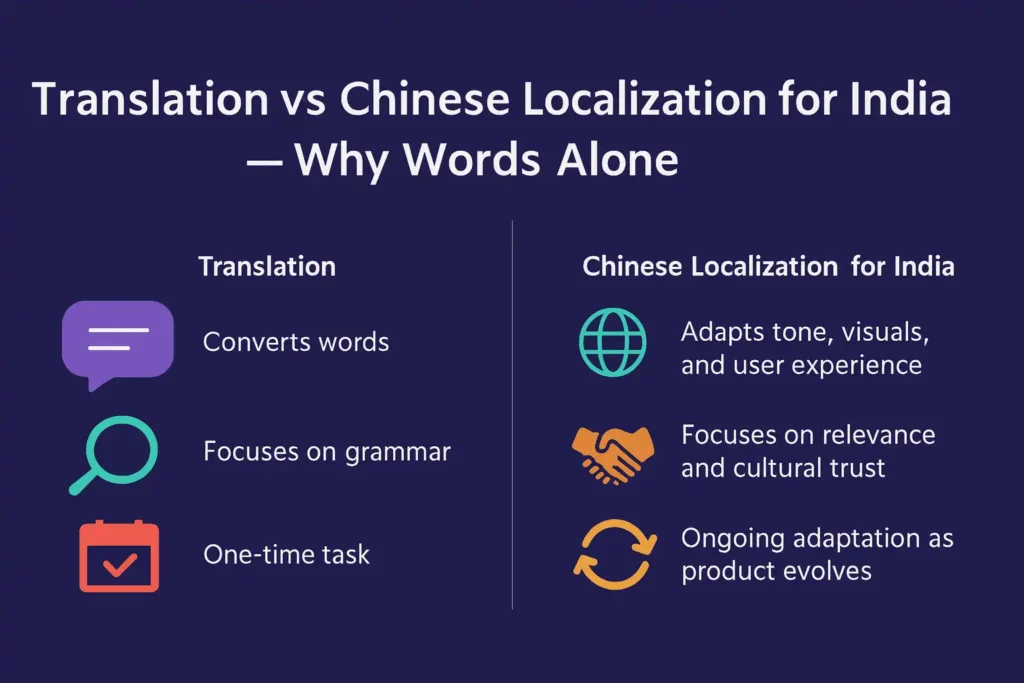China and India are two of the world’s fastest-growing innovation economies — yet they often struggle to speak each other’s language, both literally and culturally. For Indian startups looking for Chinese funding, translation alone isn’t enough. Investors in Beijing or Shenzhen expect communication that feels local, credible, and fluent.
That’s where Chinese Localization for India becomes more than a marketing tactic — it’s your bridge to trust, investment, and long-term collaboration. Many founders underestimate how powerful Chinese Localization for India can be in transforming global ideas into investor-ready communication.
What You’ll Learn
In this post, you’ll discover:
- Why Chinese Localization for India is essential for Indian startups reaching Chinese investors.
- What real companies like InMobi, OYO, and Capillary Technologies learned from their China expansion.
- How to localize your pitch decks, websites, and videos effectively.
- How to measure your localization ROI and prove that every rupee spent brings measurable results.
- Practical steps to build credibility and attract investors who think — and decide — in Chinese.
While this post focuses on attracting Chinese investors, the same strategies apply to manufacturers, software firms, and training providers doing business with China. Each depends on one principle: trust built through precise, localized communication.
Why Do Indian Startups Need Chinese Localization for India to Reach Chinese Investors?
India has become one of the world’s fastest-growing innovation hubs, with over 112,000 registered startups by 2025. Venture capital investment reached US $13.7 billion in 2024 (Bain & Company).
Yet when it comes to China — one of the world’s largest capital markets — language and cultural barriers still block collaboration.
Between 2021 and 2025, Indian startups closed 29 funding deals with Chinese investors worth US $2.4 billion, while Chinese venture funds invested US $12 billion in domestic AI and semiconductor startups.
The business opportunity is clear, but perception is the real challenge.
For many Chinese investors, poorly localized materials are a red flag:
“If they can’t present clearly in our language, can they handle our market?”
Professional Chinese Localization for India removes that barrier and replaces uncertainty with confidence.
What Do Chinese Investors Really Notice?
Chinese investors assess not just your product but your readiness for cross-border cooperation. They ask:
- Does this team understand our business etiquette?
- Are their materials professionally localized or machine-translated?
- Will they adapt to Chinese platforms and expectations?
Successful Chinese Localization for India goes far beyond words — it’s about tone, layout, and cultural awareness.
- Visuals use good Chinese fonts such as Noto Sans SC or Source Han Sans for readability.
- Colors and spacing follow balanced Chinese design norms.
- Language tone feels respectful — using 您 instead of 你.
- Dates and numbers follow Chinese standards (2025年10月13日).
These cues show that your team has invested in Chinese Localization for India — and that you understand both the language and the culture behind the capital.
Translation vs Chinese Localization for India — Why Words Alone Aren’t Enough

For example:
“Our app makes education accessible for everyone.”
becomes
“我们让优质教育触手可及” — “We bring quality education within reach.”
That phrasing sounds native, emotional, and persuasive — exactly what investors respond to.
How Did OYO Rooms Win Over Chinese Investors Through Localization?
When Indian hotel-tech startup OYO Rooms expanded to China, it didn’t just copy its Indian business model — it localized everything for Chinese owners and guests.
- The brand name and interface were adapted to Chinese language and user habits.
- The company partnered with China Lodging Group (Huazhu) to gain local market trust and distribution.
- All management tools, contracts, and customer communication were translated and localized in Simplified Chinese.
- They hired Chinese executives and built a local team to handle operations, marketing, and hotel relations.
This deep adaptation helped OYO become one of the largest hotel chains in China within just two years. Local investors and hotel owners perceived OYO as a “Chinese company with Indian roots.”
OYO’s experience proves that Chinese Localization for India is not limited to translating a website or pitch deck — it’s a complete commitment to local language, culture, and business ecosystem.
Localization turned OYO from a foreign entrant into a trusted local partner for hundreds of Chinese hotels.
How Can Indian Startups Implement Chinese Localization for India Effectively?
1. What Should a Localized Pitch Deck Include?
A well-localized pitch deck reflects clarity, structure, and cultural fit.
- Use bilingual slides (English + Simplified Chinese).
- Translate metrics (市场份额 = market share, 投资回报率 = ROI).
- Apply design principles of Chinese Localization for India, balancing space and typography.
- Avoid slang or idioms that lose meaning in translation.
2. How Can You Mirror Your Website for Chinese Users?
A core part of Chinese Localization for India is website accessibility.
If your site is slow or blocked, Chinese investors may never see your message.
Follow best practices for website mirroring China:
- Host a mirrored version on a Hong Kong or Singapore server.
- Optimize for Baidu SEO, not Google.
- Translate essential pages: About, Products, Contact.
- Replace blocked elements (YouTube → Youku, Google Maps → Amap).
- Use culturally familiar visuals and warm color palettes.
This ensures your localized site loads fast, looks authentic, and communicates seamlessly.
3. Why Is Accurate Translation of Legal and Financial Documents So Important?
In China, precision equals professionalism.
Translate and certify:
- Shareholder agreements and NDAs.
- Compliance policies and data protection statements.
- Audited financial reports and appendices.
Each file localized through Chinese Localization for India builds trust with investors and regulators alike.
4. Should You Add Subtitles in Chinese to Product Videos?
Absolutely. Videos are often your first impression.
Use professional subtitles in Chinese, not auto captions.
- Keep timing precise and font clear.
- Use Simplified Chinese for mainland viewers.
- Let native editors check tone and pacing.
Subtitles are a subtle but powerful part of Chinese Localization for India — they humanize your brand and build instant trust.
5. How Do Chinese Investors Prefer to Communicate — Email or WeChat?

Most prefer WeChat.
Set up a bilingual WeChat Official Account with your logo and contact info.
When writing:
- Be brief and respectful.
- Avoid humor or emojis early on.
- Follow professional tone — 简洁、礼貌、有重点 (“concise, polite, focused”).
It’s another key step in making Chinese Localization for India feel complete and credible.
Are Chinese Companies Still Operating in India?
Chinese enterprises remain active partners in India, contributing to sectors such as telecom, electronics, e-commerce, and electric vehicles.
| Sector | Company | Role |
|---|---|---|
| Telecom | Huawei | R&D and enterprise solutions |
| Consumer Electronics | Xiaomi, Vivo, Oppo | Local assembly and retail |
| Electric Vehicles | BYD | EV and battery production |
| E-Commerce | Alibaba Group | Investments in Paytm, Zomato |
| Appliances | Haier | Smart home manufacturing |
Each of these partnerships relies on bilingual documentation and localized training — practical proof that Chinese Localization for India strengthens cooperation.
What Products Come from China to India — and Why Does Localization Matter?

Top imports include electronics, machinery, APIs for pharmaceuticals, and solar components.
Each category demands technical documentation and labeling in Chinese.
One mistranslated line in a safety sheet can cause customs rejection or fines.
Professional Chinese Localization for India eliminates those costly risks.
Does India Still Do Business with China?
Trade between India and China remains substantial and continues to grow.
By 2024, bilateral trade reached USD 135 billion, marking a 17 % increase since 2021.
China stands as India’s largest source of imports and its third-largest export destination — proof that collaboration between the two Asian giants remains economically significant.
India’s primary exports to China include:
- Iron ore and steel products
- Organic chemicals and pharmaceuticals
- Cotton, textiles, and synthetic fibers
- Petroleum products
- Agricultural goods such as rice and seafood
Meanwhile, China exports a vast range of electronics, industrial machinery, and components essential to India’s technology and energy sectors.
This depth of exchange means that Chinese Localization for India is no longer optional.
Accurate bilingual documentation, compliant labeling, and culturally adapted product communication are now indispensable for clarity, compliance, and long-term credibility in both markets.
Which Countries Buy the Most from India — and Where Does China Rank?
India’s top export destinations (2025):
- United States
- United Arab Emirates
- China
- Netherlands
- Singapore
China ranks #3 — proof that Chinese Localization for India isn’t optional; it’s part of doing business globally.
How Does Chinese Localization for India Build Investor Confidence?
According to Common Sense Advisory (2025):
- 76 % of buyers prefer native-language content.
- Localized sites convert 25–30 % better.
- B2B deals close 40 % faster after localization.
For Indian founders, Chinese Localization for India directly increases response rates, accelerates negotiations, and demonstrates commitment.
What Are the Most Common Chinese Localization for India Mistakes Startups Make?
Many founders misunderstand what Chinese Localization for India really involves.
Common errors include:
- Using Google Translate for investor decks.
- Rushing translation just before meetings.
- Ignoring fonts or formatting.
- Translating brand names that should stay original.
- Skipping review by native editors.
How Can You Measure the ROI of Chinese Localization for India?
| Metric | Impact | Example |
|---|---|---|
| Investor Response Rate | +30 % | Bilingual pitch decks |
| Deal Speed | Up to 40 % faster | Localized contracts |
| Trust Index | Higher credibility | Consistent tone |
| Brand Recall | +20 % | Chinese-language website |
Tracking the ROI of Chinese Localization for India helps prove its business value and justify future investment.
Quick Checklist for Founders
✅ Localize your pitch deck (English + Simplified Chinese)
✅ Mirror your website for China
✅ Translate legal and financial docs
✅ Add Chinese subtitles to videos
✅ Choose good Chinese fonts for design
✅ Hire native editors for review
✅ Maintain WeChat communication in Chinese
Beyond Translation — Building Trust
In China, trust always precedes transactions.
When your brand communicates fluently through Chinese Localization for India, investors see partnership, not just potential.
Localization bridges the gap between “interested investors” and “signed partners.”
Conclusion: Why Chinese Localization for India Is the Smartest Investment You Can Make

China remains a vital funding source for Indian tech, manufacturing, and EdTech startups.
Language barriers, however, still limit access.
Professional Chinese Localization for India — covering fonts, subtitles, websites, and investor communication — proves your seriousness and cultural intelligence.
Localization isn’t cosmetic; it’s strategic.
A bilingual deck and localized website can turn “maybe later” into “let’s schedule a meeting.”
If your company — whether a startup seeking investment or a growing exporter — is ready to reach Chinese partners confidently, now is the time to act.
Start your localization journey with AZ-LOC.
Our team of expert linguists and industry specialists helps you:
- Localize your business pitch and digital presence for Chinese audiences.
- Build trust through accurate, culturally fluent communication.
- Present your brand as a reliable partner to Chinese investors and clients.
Get in touch today to see how professional Chinese Localization for India can open new markets — and turn interest into long-term collaboration.
8 Must-Have Website Localization Features for the Chinese Market (2025)
Localization Differences in Chinese vs. Western Website Design – 5 Key Insights
